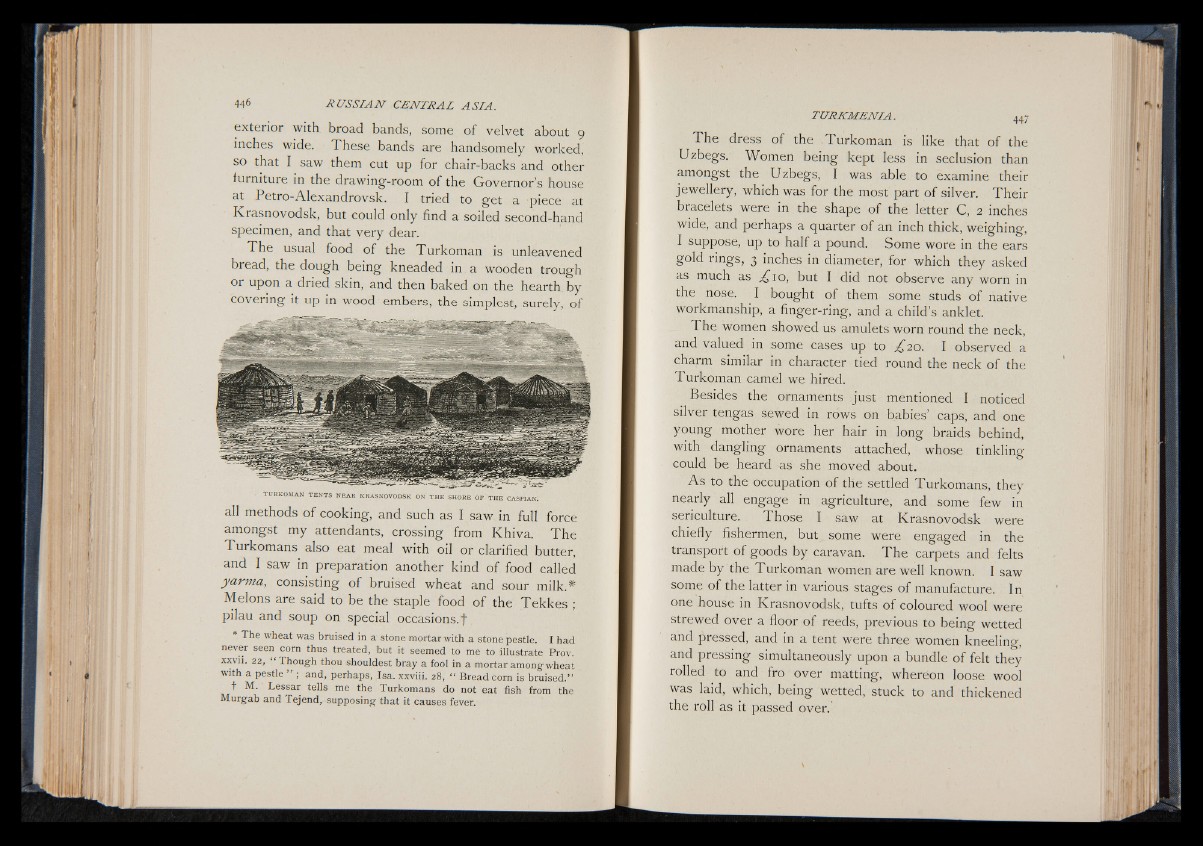
exterior with broad bands, some of velvet about 9
inches wide. These bands are handsomely worked,
so that I saw them cut up for chair-backs and other
furniture in the drawing-room of the Governor’s house
at Petro-Alexandrovsk. I tried to get a piece at
Krasnovodsk, but could only find a soiled second-hand
specimen, and that very dear.
The usual food of the Turkoman is unleavened
bread, the dough being kneaded in a wooden trough
or upon a dried skin, and then baked on the hearth by
covering it up in wood embers, the simplest, surely, of
TUR KOM AN T EN T S NE AR KRASNOVODSK ON TH E SHORE OF TH E CASPIAN.
all methods of cooking, and such as I saw in full force
amongst my attendants, crossing from Khiva. The
Turkomans also eat meal with oil or clarified butter,
and I saw in preparation another kind of food called
yarma, consisting of bruised wheat and sour milk.*
Melons are said to be the staple food of the Tekkes ;
pilau and soup on special occasions, j"
* The wheat was bruised in a stone mortar with a stone pestle. I had
never seen corn thus treated, but it seemed to me to illustrate Prov.
xxvii. 22, “ Though thou shouldest bray a fool in a mortar amongwheat
with a pestle ; and, perhaps, Isa. xxviii. 28, “ Bread com is bruised.”
t M. Lessar tells me the Turkomans do not eat fish from the
Murgab and Tejend, supposing that it causes fever.
The dress of the Turkoman is like that of the
Uzbegs. Women being kept less in seclusion than
amongst the Uzbegs, I was able to examine their
jewellery, which was for the most part of silver. Their
bracelets were in the shape of the letter C, 2 inches
wide, and perhaps a quarter of an inch thick, weighing,
I suppose, up to half a pound. Some wore in the ears
gold rings, 3 inches in diameter, for which they asked
as much as £¡10, but I did not observe any worn in
the nose. I bought of them some studs of native
workmanship, a finger-ring, and a child’s anklet.
The women showed us amulets worn round the neck,
and valued in some cases up to ,¿"20. I observed a
charm similar in character tied round the neck of the
Turkoman camel we hired.
Besides the ornaments just mentioned I noticed
silver tengas sewed in rows on babies’ caps, and one
young mother wore her hair in long braids behind,
with dangling ornaments attached, whose tinkling
could be heard as she moved about.
A s to the occupation of the settled Turkomans, they
nearly all engage m agriculture, and some few in
sericulture. Those I saw at Krasnovodsk were
chiefly fishermen, but some were engaged in the
transport of goods by caravan. The carpets and felts
made by the Turkoman women are well known. I saw
some of the latter in various stages of manufacture. In
one house in Krasnovodsk, tufts of coloured wool were
strewed over a floor of reeds, previous to being wetted
and pressed, and in a tent were three women kneeling,
and pressing simultaneously upon a bundle of felt they
rolled to and fro over matting, whereon loose wool
was laid, which, being wetted, stuck to and thickened
the roll as it passed over.